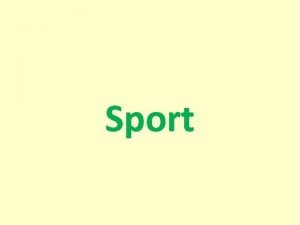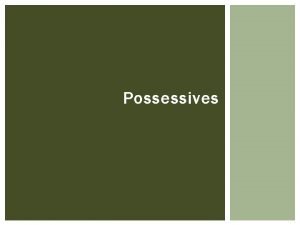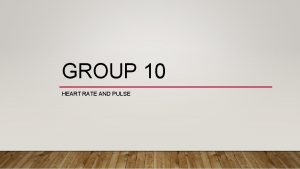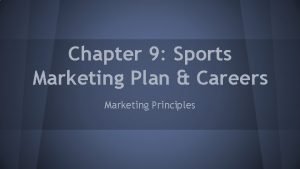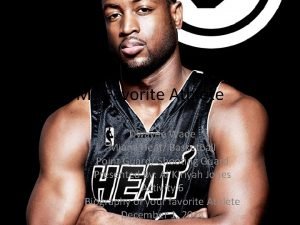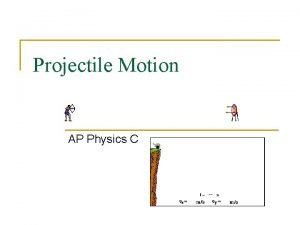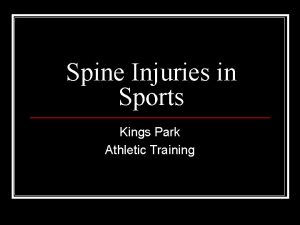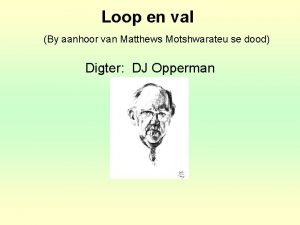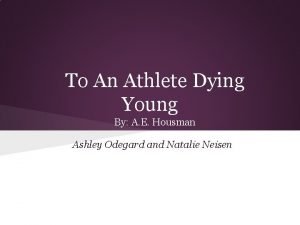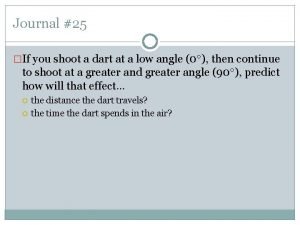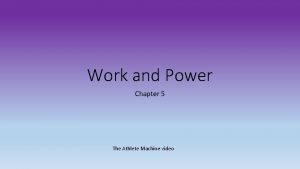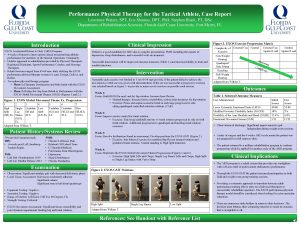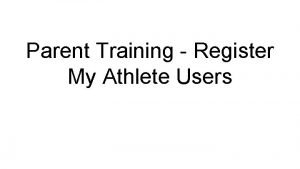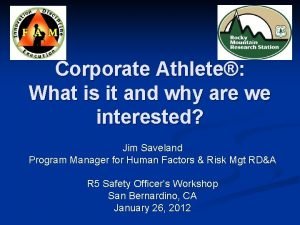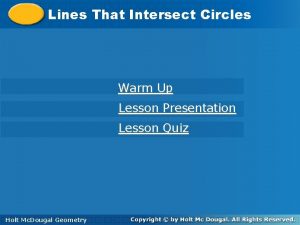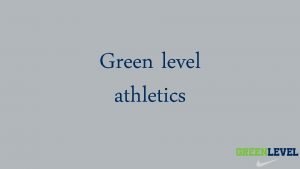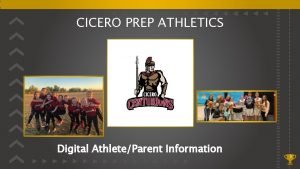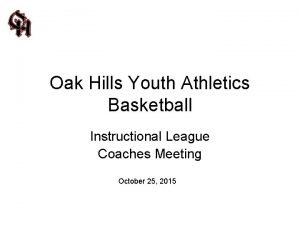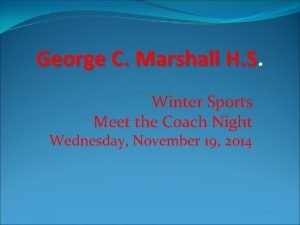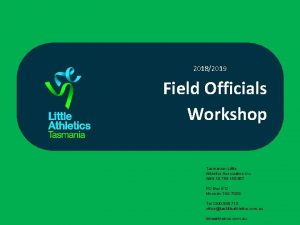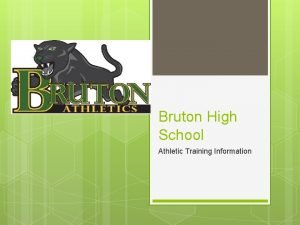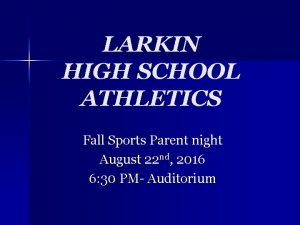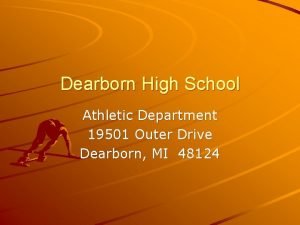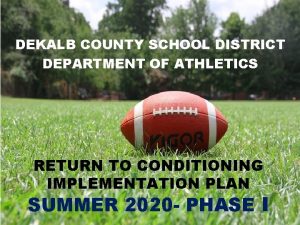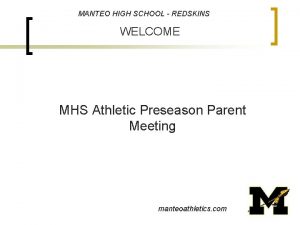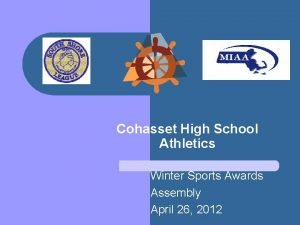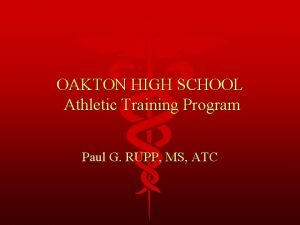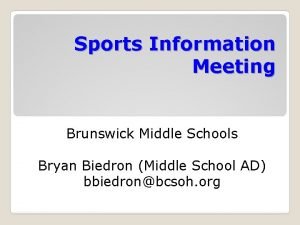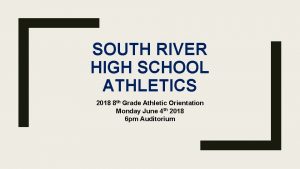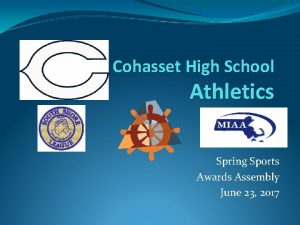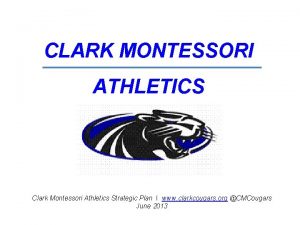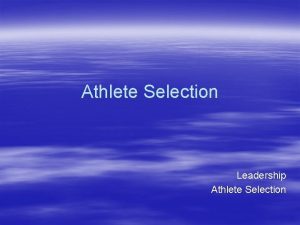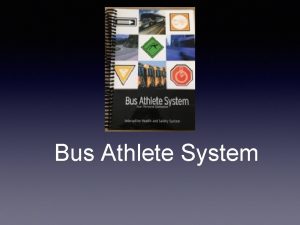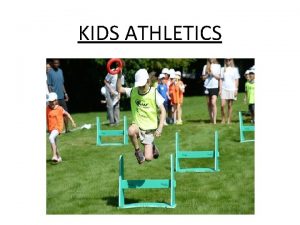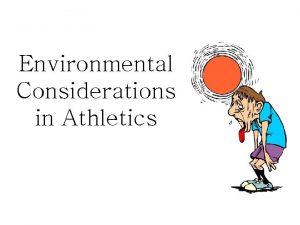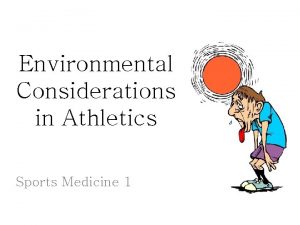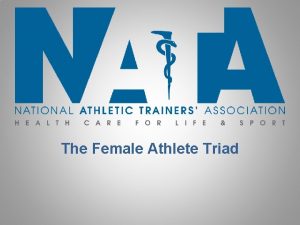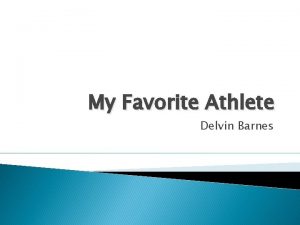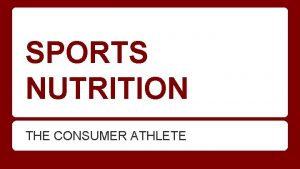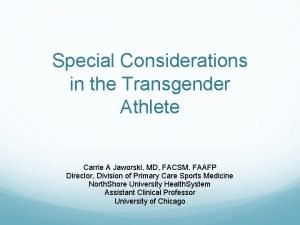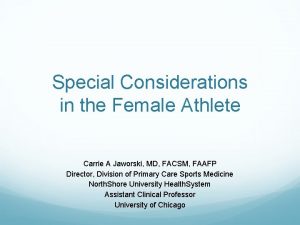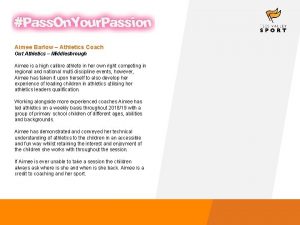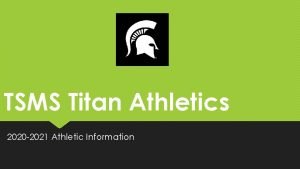Special Considerations Special Considerations in Athletics Each athlete






























































- Slides: 62

Special Considerations

Special Considerations in Athletics Each athlete brings unique conditions or concerns ◦ Important for the athletic staff to know ◦ Range from previous injuries to potentially lifethreatening allergies to bee stings ◦ Training staff needs to be aware so they can be prepared 2

Environmental Conditions Affecting Athletes Conditions occasionally arise that may prevent the body from maintaining homeostasis. ◦ For example, heat and cold Particularly damp or windy conditions ◦ These conditions may create health problems for athletes in the course of routine practice or competitive play. 3

Environmental Heat Stress Exertion leads to perspiration. Perspiration (sweat) depletes the body of water, as does urination. If eliminated fluid is not replaced, dehydration will result. The rate at which perspiration evaporates is strongly influenced by humidity. 4

Environmental Heat Stress Humidity is the amount of moisture that is in the air. Relative humidity is based on the difference between the amount of water vapor in the air and the maximum amount the air could contain at the same temperature. ◦ Used to calculate the Heat Index 5

Environmental Heat Stress Heat Index combines air temperature and humidity to determine how hot it actually feels ◦ A psychrometer can be used to determine the relative humidity. Wet-bulb(WBGT)? ? ◦ The calculation used measures the heat stress in direct sunlight. ◦ This type of reading also takes into account the temperature, wind speed, humidity, the angle of the sun and the solar radiation (or simply, the cloud cover). 6

Environmental Heat Stress Sunburn ◦ A potential hazard for anyone who participates in outdoor activities without proper protection ◦ Caused by ultraviolet (UV) rays from the sun ◦ Can cause skin cancer and premature aging of the skin 7

Heat-Related Illness A preventable sports problem An accumulation of body heat that results when the body’s ability to cool itself is overwhelmed 8

Hyperthermia – condition in which, for one reason or another, body temperature is elevated Vitally important that the AT and the coach has a knowledge about temperature and humidity factors prior to planning workout

Heat Stress Heat stress can affect everyone, regardless of the level of physical conditioning Prolonged exposure to extreme heat can result in heat illness Numerous deaths occur each year as a result of heat stress – it is entirely preventable While heat related illnesses most often occur in hot, humid conditions, it can also possibly occur in cold conditions if dehydration or other issues occur

Physiological Processes of Body � � � Metabolic Heat Production – the higher the metabolic rate, the more heat produced Conductive Heat Exchange – Physical contact with other objects result in either a heat loss or heat gain (ex. Standing on hot turf or wearing a helmet) Convective Heat Exchange – Occurs when either a mass of air or water moves around an individual (Breeze) Radiant Heat Exchange – radiant heat from the sun causes body temp to rise Evaporative Heat Loss – When the temp of the environment becomes higher than body temp, sweat occurs � Important to monitor sweating in certain individuals


Guidelines for Preventing Heat-Related Disorders Record athletes’ weight before and after practice ◦ Weight loss in excess of 3% of body weight from sweating should be noted. ◦ Observe for signs of heat exhaustion for those who lose more than 3 percent of their weight. ◦ A loss of more than 7% of body weight means that the athlete should see a physician. 13

Guidelines for Preventing Heat-Related Disorders Check the percentage of body fat for each athlete. ◦ Athletes with a low percentage will be more likely to experience heat cramps. Check the weather forecast before practice and competition. 14

Guidelines for Preventing Heat-Related Disorders Be aware of the duration and intensity of practice in hot and humid weather. Use acclimatization strategies. ◦ Enable athletes to become accustomed to temperature and environmental conditions that may change between in- and off-season 15

Guidelines for Preventing Heat-Related Disorders Select clothing in accordance with temperature and humidity. ◦ Sweat-soaked shirts should be changed. Athletes should avoid caffeine, alcohol, and carbonated beverages. Be sure the athletes replenish every lost pound with 20 ounces of fluid. 16

Guidelines for Preventing Heat-Related Disorders Thirst is not an adequate indicator for water needs during exercise. Be sure athletes drink fluids before exercising: ◦ ◦ 17 -20 ounces 2 to 3 hours before 7 -10 ounces 10 -20 minutes before 17

Guidelines for Preventing Heat-Related Disorders During exercise. ◦ ◦ Have athletes drink 7 -10 ounces of fluid every 10 -15 minutes. Have water continually available. Remind athletes that water from cold fluids empties from the stomach faster than water from warm fluids. 18

Guidelines for Preventing Heat-Related Disorders Athletes should monitor the color and volume of their urine. ◦ ◦ ◦ Light colored urine is normal. Dark yellow urine with a strong odor means the athlete needs to drink more fluid. Vitamins can change the color and odor of urine. 19

Guidelines for Preventing Heat-Related Disorders An athlete with a fever is more susceptible to heat problems. Fluids that athletes drink during practice should also be available at competitions. Some sports drinks are better than water because they contain important electrolytes. 20

Guidelines for Preventing Heat-Related Disorders Salt can be added to water or sports drinks at ½ teaspoon per one quart. A well-balanced diet with limited fat consumption helps to prevent heat problems. Be aware of the concern with “energy drinks” and what is in them. 21

Preventing Heat Illness Hydration ◦ Athletes should always begin activities in a well hydrated state Urine Light yellow in color (lemonade) = properly hydrated Dark color in urine (cider) = dehydration • It is always important to space fluid intake out rather than trying to “cram” at last minute • Important to drink 17 -20 fluid ounces of water prior to workout (2 -3 hours)and 7 -10 fluid ounces immediately before workout (10 -20 minutes)

Urine Color Chart

Dehydration � � � An athlete who does not replenish fluids is likely to become dehydrated An individual is said to have mild dehydration when fluids lost are less than 2 % of normal body weight Symptoms: � Thirst � Dry Mouth � Headache � Dizziness � Possibly cramps

Fluid and Electrolyte Replacement If the athlete ignores the thirst impulse and continues to work out, dehydration sets in Many athletes only replace 50% of the water they lose through sweating, leaving their system in a deficit Athletes must have unlimited access to fluids, both prior to, DURING and after workouts

Ways to Prevent Heat Illness � Adequate � Gradual access to water during workouts Acclimatization � Identifying ◦ Who? ? ? � Selecting Susceptible Individuals Appropriate Uniforms � Monitoring the Heat Index ◦ Heat Policy in place to protect the athletes

Possible Causes of Heat-Related Illness Inadequate heat acclimatization Inadequate fitness level Salt deficiency Presence of Higher body fat gastrointestinal Dehydration distress Illness or fever Inadequate meals 27

Possible Causes of Heat-Related Illness Insufficient energy intake Skin conditions Ingestion of medications or dietary supplements Overly motivated athletes Athletes reluctant to report problems 28

Recognizing and Managing Exertional Heat Illness Heat Rash ◦ Benign condition associated with a red, raised rash accompanied by sensations of prickling and tingling during sweating Heat Syncope ◦ Also called heat collapse ◦ Associated with rapid physical fatigue during overexposure to heat ◦ Treated by laying athlete down in a cool environment and replacing fluids

Recognizing and Managing Exertional Heat Illness � Exertional Heat Cramps � Muscle spasms, usually in the stomach or calf (not limited to those areas) � Related to excessive loss of water and electrolytes � Profuse sweating leads to imbalance within muscles, ultimately leading to extreme cramps � Prevented by adequate replacement of electrolytes � Immediate treatment is ingestion of large quantities of water, mild prolonged stretching with ice massage of muscle � High chance of reoccurrence, so usually leads to removal of additional workouts for the remainder of the day

Recognizing and Managing Exertional Heat Illness � Exertional Heat Exhaustion �Occurs when an athlete becomes dehydrated to the point that the body is unable to sustain adequate cardiac output and cannot continue with workout �Body temperature (as gauged by rectal temperature) is less that 104 degrees �Must be immediately removed and taken to cool area �Legs elevated / cooling attempted / rehydration essential (IV if necessary) �If rapid improvement is noticed, transport is necessary

Recognizing and Managing Exertional Heat Illness � Exertional Heatstroke � Serious, life threatening emergency � Body temperature rise affects CNS, body tissue, extreme circulatory and metabolic stresses occur as well as physiological dysfunction � Can occur suddenly without warning � Body temperature is recorded at 104 or higher � Hot skin and may have an absence of sweating � Body temperature must be lowered as fast as possible Cold water bath Cold towels Must be transported as soon as possible


Environmental Cold Stress Wind and moisture can complicate performance in cold weather. Wind-chill factor ◦ Effect of wind in cold temperatures ◦ Velocity of wind cools the air, making temperatures even cooler than thermometer reads Precautions must be taken when participating in any cold-weather sport. 34

Hypothermia – cold weather can cause the body to lose temperature, leading to medical emergencies Low temperatures alone can cause problems, but when wind is added, chill factor is more of a concern A third factor, dampness or wetness, further increases the chance of hypothermia

Prevention Apparel must be geared to the weather ◦ If damp, needs to be changed regularly Proper warm up Proper rehydration ◦ Yes, you can get dehydrated in cold conditions

Common Cold Injuries Frost Nip ◦ Involved ears, nose, cheeks, chin, fingers and toes ◦ Commonly occurs when there is a High wind Severe cold Combination of the two ◦ Can be treated with firm, sustained pressure (no rubbing), blowing hot breath or covering with warm clothes

Common Cold Injuries � Frostbite � Prolonged and constant exposure to the cold can cause issues in the fingers and the toes � Caused by issues in peripheral circulation and can be avoided by proper cover and removal from cold exposure � Superficial frostbite- involves only skin and subcutaneous tissue Rewarming in warm water (101 -110 degrees) will help with issues � Deep frostbite – Serious injury indicating tissues are frozen Requires immediate hospitalization Rapid rewarming is required Possible loss of affected areas

Superficial Frostbite

Deep Frostbite

Lightning Safety • • Number two causes of environmental deaths annually (responsible for 110 deaths per year) Every institution must have a policy in place to deal with lightning • Policy must include: • • Who monitors Who makes decision to halt play How long play is suspended Where athletes and spectators are moved during delay

Lightning Know where the nearest shelter is and how long it takes to get there. Flash-to-bang method 30/30 rule 42

Where to (and where not to) go Yes ◦ ◦ ◦ Indoors Car Ditch Ravine Valley If lightning strikes around you, do not lie flat but rest in a crouched position

Where to (and where not to) go No ◦ ◦ ◦ Around a large tree, flagpole or light pole Hill Bleachers Under an umbrella Anywhere close to standing water

Flash to Bang � � � The most dangerous storms give little or no warning Lightning is always accompanied by thunder, although 20 – 40 % of thunder is never heard Flash-to-bang method provides an estimation of how far away lightning is occurring � When you see lightning, count the number of seconds until you hear thunder. At that point, divide by 5 and you have your mile estimation � Ex: 30 seconds between flash and bang = approx. 6 miles away � Policy = 30 seconds or less means play is suspended and shelter is found

Electronic Lightning Detectors? ? Some can detect lightning as far as 40 miles away Are they accurate? ◦ ◦ ◦ Electronic Overload Stadium Lights Cell Phones Ipods Wireless Internet Golf Carts

Football Player Killed By Lightning Strike September 28, 2012 COCONUT CREEK, FL -- A High School football player in South Florida was killed after getting struck by lightning. Several others were hurt. 15 -year-old Schaffner Noel was struck in the chest. He was taking part in a football game Wednesday afternoon between Monarch High School and Pompano High School. Another player and a cheerleader who were standing next to Noel, were hurt. Officials say they were hospitalized in serious but stable condition. They also say a police officer also fell down and ten other students were treated for cuts, bruises and abrasions. School officials said they had called off the football game when the storm began, and the students were coming off the field when the player was struck

Air Pollution Significant problem everywhere in the United States, but particularly in urban areas with large industries and heavy automobile traffic ◦ Affects heat index ◦ Affects athletes with asthma ◦ Affects athletes with allergies

Skin Conditions in Athletes Acne mechanica ◦ Acne that results from heat, pressure, occlusion, and friction Plantar warts ◦ Small, hard growths on the bottom of the foot Herpes gladiatorum ◦ Herpes simplex infection transmitted through skinto-skin contact 4 9

Skin Conditions in Athletes (cont’d. ) Fungal infections ◦ Tinea pedis: fungal infection that thrives in warmth and dampness Blisters ◦ Friction, heat, and moisture increases risk ◦ Tear occurs within upper skin layers, forming a space into which that fluid seeps 5 0

Skin Conditions in Athletes (cont’d. ) Abrasions ◦ Normally caused by poorly fit equipment or rubbing of skin Jogger’s nipples ◦ Constant chafing between a runner’s nipples and shirt causes painful, crusted lesions that bleed 5 1

Diabetes Disease in which the body does not produce or properly use insulin ◦ A hormone needed to make cells absorb sugar from blood Genetics and environmental factors (e. g. , lack of exercise) appear to play roles 5 2

Diabetes (cont’d. ) Type 1 diabetes ◦ Results from the body’s failure to produce insulin Type 2 diabetes ◦ Occurs when the body still makes insulin but: Does so in insufficient amounts or Produces insulin that does not function properly 5 3

Diabetes (cont’d. ) Diabetic emergencies ◦ Insulin reaction Occurs when there is too much insulin in the body ◦ Diabetic coma Occurs when there is too much sugar and too little insulin in the blood 5 4

Seizure Disorders Disruptions of normal brain activity ◦ Epilepsy: seizures recurr regularly ◦ Other causes include: Infections, high fever, brain tumors, drugs, strokes, bleeding in the brain, trauma to the brain, and low blood glucose, sodium, or calcium 5 5

Seizure Disorders (cont’d. ) Types: ◦ Simple partial seizure Jerking begins in one area of the body Cannot be stopped, but person stays awake and aware ◦ Generalized tonic-clonic seizures Characterized by a sudden cry, falling, and rigidity, followed by muscle jerks, shallow breathing or temporarily suspended breathing, bluish skin, and possible loss of bladder or bowel control 5 6

Insect Bites and Stings Two greatest risks: ◦ Allergic reactions Local Systemic ◦ Infections Epinephrine injection is the only effective immediate treatment 5 7

The Female Athlete Triad Combination of: ◦ Disordered eating ◦ Amenorrhea (lack of menstrual periods) ◦ Osteoporosis 5 8


The Female Athlete Triad (cont’d. ) Warning signs: ◦ ◦ ◦ ◦ Frequent or unexplained injuries Excessive or compulsive exercise Change in performance Impaired concentration Absent or irregular menstrual periods Restrictive eating Use of weight-loss products or supplements 6 0

Conclusion Many health and safety factors that must be taken into account when participating in athletics ◦ Factors (e. g. , the environment) can turn a positive situation into a dangerous one Understanding causes of environmental-related illnesses helps the athlete plan ahead and stay within safe limits 6 1

Conclusion (cont’d. ) Other concerns are specific medical conditions that may limit or curtail athletic competition ◦ The athlete must be made aware of illnesses and conditions that can affect their performance and health ◦ Quick recognition and treatment will ensure good health and optimal performance 6 2
 Decathlonü
Decathlonü Athlete possessive form
Athlete possessive form Action head bumps ball reaction
Action head bumps ball reaction Athlete's circle of care definition
Athlete's circle of care definition Communicable and noncommunicable diseases venn diagram
Communicable and noncommunicable diseases venn diagram Pulse rate group
Pulse rate group Embarrass suffix
Embarrass suffix Sports marketing principles
Sports marketing principles Pele greatest athlete of all time
Pele greatest athlete of all time My favorite athlete is
My favorite athlete is An athlete throws a javelin to a maximum distance of 80m
An athlete throws a javelin to a maximum distance of 80m Back pain kings park
Back pain kings park Average resting heart rate for men
Average resting heart rate for men Lyric poetry and narrative poetry
Lyric poetry and narrative poetry Loop en val athlete
Loop en val athlete Ashly odegard
Ashly odegard What do you call the path followed by a projectile?
What do you call the path followed by a projectile? Athlete plural possessive
Athlete plural possessive Occupational athletics
Occupational athletics The athlete machine
The athlete machine Modified tactical athlete performance assessment
Modified tactical athlete performance assessment Which athlete has the most olympic gold medals
Which athlete has the most olympic gold medals Olympic background images
Olympic background images Register my athlete login
Register my athlete login Corporate athlete personal development plan
Corporate athlete personal development plan 7-3 practice more multiplication properties of exponents
7-3 practice more multiplication properties of exponents Identify each line or segment that intersects each circle
Identify each line or segment that intersects each circle Inzan athletics
Inzan athletics Green level athletics
Green level athletics Boone grove athletics
Boone grove athletics Cicero prep athletics
Cicero prep athletics Oak hills youth athletics
Oak hills youth athletics Gcm hs
Gcm hs North haven high school athletics
North haven high school athletics Gsrsd
Gsrsd Avenger athletics
Avenger athletics Centreville high school logo
Centreville high school logo Hopewell middle school athletics
Hopewell middle school athletics Troy buchanan high school football
Troy buchanan high school football Tasmanian little athletics
Tasmanian little athletics Bruton high school athletics
Bruton high school athletics Larkin athletics 8 to 18
Larkin athletics 8 to 18 Logan high school
Logan high school European athletics
European athletics Pghs sports
Pghs sports Dearborn high athletics
Dearborn high athletics Bishop noll athletics
Bishop noll athletics Dekalb county athletic director
Dekalb county athletic director Manteo athletics
Manteo athletics Bobby nahill
Bobby nahill Mvhs athletics
Mvhs athletics Culture athletics
Culture athletics Oakton high school accident
Oakton high school accident Bcsoh athletics
Bcsoh athletics Bow high school athletics
Bow high school athletics South river high school athletics
South river high school athletics Kids' athletics programme
Kids' athletics programme European athletics
European athletics Wayland high school athletics
Wayland high school athletics Maus middle school
Maus middle school Ava worthington cohasset
Ava worthington cohasset Tex hill middle school athletics
Tex hill middle school athletics Clark montessori athletics
Clark montessori athletics
